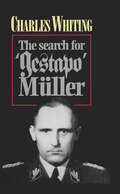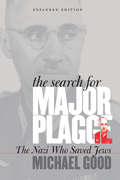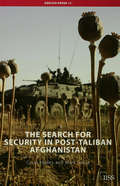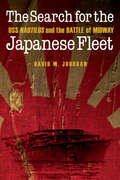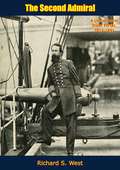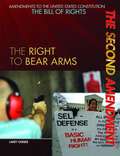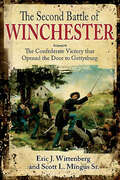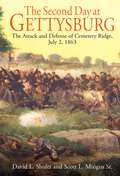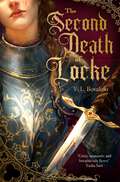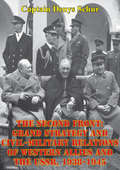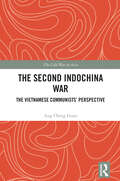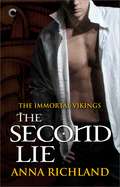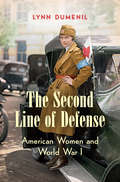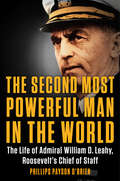- Table View
- List View
The Seaforth Bibliography: A Guide to More Than 4000 Works on British Naval History 55BC – 1815
by Eugene RasorThis remarkable work is a comprehensive historiographical and bibliographical survey of the most important scholarly and printed materials about the naval and maritime history of England and Great Britain from the earliest times to 1815. More than 4,000 popular, standard and official histories, important articles in journals and periodicals, anthologies, conference, symposium and seminar papers, guides, documents and doctoral theses are covered so that the emphasis is the broadest possible. But the work is far, far more than a listing. The works are all evaluated, assessed and analysed and then integrated into an historical narrative that makes the book a hugely useful reference work for student, scholar, and enthusiast alike. It is divided into twenty-one chapters which cover resource centres, significant naval writers, pre-eminent and general histories, the chronological periods from Julius Caesar through the Vikings, Tudors and Stuarts to Nelson and Bligh, major naval personalities, warships, piracy, strategy and tactics, exploration, discovery and navigation, archaeology and even naval fiction. Quite simply, no-one with an interest and enthusiasm for naval history can afford to be without this book at their side.
The Search (Grace Livingston Hill Series #39)
by Grace Livingston HillJohn Cameron knew Ruth Macdonald was out of his league. He was a simple soldier, seeking to fulfill his duty. She was the well-known daughter of a wealthy family, surrounded by friends, parties, and glitter. Still, neither of them could forget the special bond they shared, forged in childhood when John had been Ruth's brave defender against Harry Wainwright, the neighborhood bully. Now John and Ruth have rediscovered each other, but can they regain what they once shared? Or will their disapproving families, the war--and the sinister intentions of Harry Wainwright--forever doom their search for God and each other?
The Search (Star Trek: Deep Space Nine)
by Diane CareyThe Dominion: The mysterious rulers of the worlds on the other side of the wormhole. The Dominion: a ruthless planet-conquering race unknown even to those they rule. The Dominion: the most dangerous foe the Federation may ever face. At the edge of the wormhole, the space station Deep Space Nine and the planet Bajor sit on what will be the front line in any Dominion attack. To try and prevent the conflict, Commander Benjamin Sisko ant his crew take a never-tested Federation warship through the wormhole to track down and confront the Dominion. If Commander Sisko fails, not only the Federation, but the Klingons, Romluans, Cardassians, and all the worlds of the Alpha Quadrant will face an interstellar war they cannot win.
The Search for Gestapo Muller
by Charles WhitingOn April 29th, 1945, General Heinrich Gestapo Muller, head of that feared Nazi organisation, left Hitler's bunker and disappeared. Today over a half a Century later, he is still carried on the books of the German Office of Investigation of Nazi war crimes as their No. 1 wanted man - The question is why?For nearly five years Muller had the power of life-and-death over 300 million Europeans in Occupied Europe. In that time not only did he play a major role in the Holocaust but he helped in kidnapping of Payne, Stevens and Best, chiefs of the SIS in Europe; had a hand in the planned abduction of the Duke of Windsor; broke the power of the European-Soviet spy ring the 'Red Orchestra'; terrorised the French resistance; shot British SAS and SOE prisoners and master-minded the executions of the Great Escape POW escapees.But was he all the time working for the Russians, and if so, what happened to him on that April day? His subordinate Eichmann escaped as did other top Gestapo officials. Did he really die in Berlin?In his search for the truth the Author takes an interesting and exciting stance. He examines, with typical thoroughness, both Muller's career as it progresses from being a simple Bavarian policeman through to becoming a top Third Reich's henchman and the Allies post-war efforts to find out if Muller survived.The Search for Gestapo Muller is a truly intriguing modern mystery story.
The Search for Major Plagge: The Nazi Who Saved Jews
by Michael GoodAn “exceptional” historical detective story that follows one man’s quest to find the German commander who saved his mother—and many other Jews (Booklist).Part detective story, part personal quest, Michael Good’s book is the story of the German commander of a Lithuanian work camp who saved hundreds of Jewish lives in the Vilnius ghetto —including the life of Good’s mother, Pearl. Who was this enigmatic officer Pearl Good had spoken of so often?After five years of research—interviewing survivors, assembling a team that could work to open German files untouched for fifty years, following every lead he could, Good was able to uncover the amazing tale of one man’s remarkable courage. And in April 2005, Karl Plagge joined Oskar Schindler and 380 other Germans as “Righteous among Nations,” honored by the State of Israel for protecting and saving Jewish lives during the Holocaust.This expanded edition features new photographs and a new epilogue on the impact of the discovery of Karl Plagge—especially the story of eighty-three-year-old Alfons von Deschwanden, who, after fifty years of silence, came forward as a veteran of Plagge’s unit. His testimony is now part of this growing witness to truth.“A rewarding tale of redemption in the face of horror.” —Kirkus Reviews
The Search for Security in Post-Taliban Afghanistan (Adelphi series)
by Mark Sedra Cyrus HodesBy the middle of 2007, Afghans had become increasingly disillusioned with a state-building process that had failed to deliver the peace dividend that they were promised. For many Afghans, the most noticeable change in their lives since the fall of the Taliban has been an acute deterioration in security conditions. Whether it is predatory warlords, the Taliban-led insurgency, the burgeoning narcotics trade or general criminality, the threats to the security and stability of Afghanistan are manifold. The response to those threats, both in terms of the international military intervention and the donor-supported process to rebuild the security architecture of the Afghan state, known as security-sector reform (SSR), has been largely insufficient to address the task at hand. NATO has struggled to find the troops and equipment it requires to complete its Afghan mission and the SSR process, from its outset, has been severely under-resourced and poorly directed. Compounding these problems, rampant corruption and factionalism in the Afghan government, particularly in the security institutions, have served as major impediments to reform and a driver of insecurity. This paper charts the evolution of the security environment in Afghanistan since the fall of the Taliban, assessing both the causes of insecurity and the responses to them. Through this analysis, it offers some suggestions on how to tackle Afghanistan’s growing security crisis.
The Search for Tactical Success in Vietnam
by Andrew Ross Robert Hall Ross, Andrew and Hall, Robert and Griffin, Amy Amy GriffinFrom 1966 to 1971 the First Australian Task Force was part of the counterinsurgency campaign in South Vietnam. Though considered a small component of the Free World effort in the war, these troops from Australia and New Zealand were in fact the best trained and prepared for counterinsurgency warfare. However, until now, their achievements have been largely overlooked by military historians. The Search for Tactical Success in Vietnam sheds new light on this campaign by examining the thousands of small-scale battles that the First Australian Task Force was engaged in. The book draws on statistical, spatial and temporal analysis, as well as primary data, to present a unique study of the tactics and achievements of the First Australian Task Force in Phuoc Tuy Province, South Vietnam. Further, original maps throughout the text help to illustrate how the Task Force's tactics were employed.
The Search for the Japanese Fleet: USS Nautilus and the Battle of Midway
by David W. Jourdan Philip G. RenaudIn The Search for the Japanese Fleet, David W. Jourdan, one of the world’s experts in undersea exploration, reconstructs the critical role one submarine played in the Battle of Midway, considered to be the turning point of the war in the Pacific. In the direct line of fire during this battle was one of the oldest boats in the navy, USS Nautilus. The actions of Lt. Cdr. William Brockman and his ninety-three-man crew during an eight-hour period rank among the most important submarine contributions to the most decisive engagement in U.S. Navy history. Fifty-seven years later, Jourdan’s team of deep-sea explorers set out to discover the history of the Battle of Midway and find the ships that the Allied fleet sank. Key to the mystery was Nautilus and its underwater exploits. Relying on logs, diaries, chronologies, manuals, sound recordings, and interviews with veterans of the battle, including men who spent most of June 4, 1942, in the submarine conning tower, the story breathes new life into the history of this epic engagement. Woven into the tale of World War II is the modern drama of deep-sea discovery, as explorers deploy new technology three miles beneath the ocean surface to uncover history and commemorate fallen heroes.
The Search: The true story of a D-Day survivor, an unlikely friendship, and a lost shipwreck off Normandy
by John Henry PhillipsWhen archaeologist John Henry Phillips volunteered with a charity that took D-Day veterans back to Normandy, due to an administrative error he found himself without a hotel room and reliant on the generosity of one of the veterans who had a spare bed. That veteran was Patrick Thomas - and it was an encounter that would change both their lives forever.Patrick's landing craft, LCH 185, had led the first wave into Sword Beach on D-Day, and stayed off Normandy until the 25th June when an acoustic mine sent it to the seabed along with most of the crew. His story transfixed John, and the resulting search for the shipwreck was to consume him.Jumping back and forwards in time, between vivid descriptions of the final days on board LCH 185 and John's thrilling search to find the shipwreck, The Search is an emotional story of a devastating time in history, an unlikely, life-changing friendship and a quest to honour a wartime home and family lost over seventy-five years ago.
The Search: The true story of a D-Day survivor, an unlikely friendship, and a lost shipwreck off Normandy
by John Henry PhillipsWhen archaeologist John Henry Phillips volunteered with a charity that took D-Day veterans back to Normandy, due to an administrative error he found himself without a hotel room and reliant on the generosity of one of the veterans who had a spare bed. That veteran was Patrick Thomas - and it was an encounter that would change both their lives forever.Patrick's landing craft, LCH 185, had led the first wave into Sword Beach on D-Day, and stayed off Normandy until the 25th June when an acoustic mine sent it to the seabed along with most of the crew. His story transfixed John, and the resulting search for the shipwreck was to consume him.Jumping back and forwards in time, between vivid descriptions of the final days on board LCH 185 and John's thrilling search to find the shipwreck, The Search is an emotional story of a devastating time in history, an unlikely, life-changing friendship and a quest to honour a wartime home and family lost over seventy-five years ago.
The Seasick Admiral: Nelson and the Health of the Navy
by Kevin BrownHoratio Nelson did not enjoy robust good health. From his childhood he was prone to many of the ailments so common in the eighteenth century, and after he joined the Navy he contracted fevers that further undermined his strength: he was even seasick whenever he first put to sea. Nevertheless, he saw more action than most officers, and was often wounded the loss of the sight in one eye and a shattered arm were the most public, but by no means his only injuries. This personal experience of sickness made him uniquely aware of the importance of health and fitness to the efficient running of a fleet, and this new book investigates Nelson's personal contribution to improving the welfare of the men he commanded.It ranges from issues of diet, through hygiene to improved medical practices. Believing prevention was better than cure, Nelson went to great lengths to obtain fresh provisions, insisted on cleanliness in his ships, and even understood the relationship between mental and physical health, working tirelessly to keep up the morale of his men. Many other people contributed to what became a revolution in naval health but because of his heroic status Nelson's influence was hugely significant, a role which this book reveals in detail for the first time.
The Second Admiral: A Life of David Dixon Porter, 1813-1891
by Richard S. WestA DEFINITIVE BUT HIGHLY EXCITING LIFE OF ONE OF THE MOST COLORFUL AND HITHERTO NEGLECTED FIGURES IN AMERICAN HISTORYDavid Dixon Porter (1813-1891) was a U.S. Navy admiral and a member of one of the most distinguished families in the history of the U.S. Navy. Promoted as the second U.S. Navy officer ever to attain the rank of admiral, Porter helped improve the Navy as the Superintendent of the U.S. Naval Academy after significant service in the American Civil War.Porter began naval service as a midshipman at the age of 10 under his father, Commodore David Porter, on the frigate U.S.S. John Adams. He served in the Mexican War in the attack on the fort at the City of Vera Cruz, commanded an independent flotilla of mortar boats at the capture of New Orleans, and later advanced to the rank of (acting) rear admiral in command of the Mississippi River Squadron, which co-operated with the army under Maj.-Gen. Ulysses S. Grant in the Vicksburg Campaign.After the fall of Vicksburg, he led the naval forces in the difficult Red River Campaign in Louisiana. Late in 1864, Porter was transferred from the interior to the Atlantic coast, where he led the U.S. Navy in the joint assaults on Fort Fisher, the final significant naval action of the war.Porter worked to raise the standards of the U.S. Navy in the position of Superintendent of the Naval Academy when it was restored to Annapolis. He initiated reforms in the curriculum to increase professionalism. In the early days of President Grant's administration, Porter was de facto Secretary of the Navy. When his adoptive brother David G. Farragut was advanced from rank of vice-admiral to admiral, Porter took his previous position; likewise, when Farragut died, Porter became the second man to hold the newly created rank of admiral. He gathered a corps of like-minded officers devoted to naval reform.
The Second Amendment
by Freya Ottem HansonPresents an overview of the Second Amendment of the United States Constitution and examines the debate that has surrounded the right to bear arms.
The Second Amendment: The Right To Bear Arms (Amendments To The United States Constitution: The Bill Of Rights)
by Larry GerberThe United States has the most guns per capita of any country in the world. Many Americans value the right to bear arms, which they believe is guaranteed by the Second Amendment to the Constitution. Others believe that the Second Amendment only guarantees the right for organized militias to own guns. This book surveys the history of the Second Amendment and gun ownership in the United States, and explores how the amendment continues to affect us today.
The Second Battle of Winchester: The Confederate Victory that Opened the Door to Gettysburg
by Eric J. Wittenberg Scott L. Mingus Sr.A comprehensive, deeply researched history of the pivotal 1863 American Civil War battle fought in northern Virginia. June 1863. The Gettysburg Campaign is underway. Robert E. Lee&’s Army of Northern Virginia pushes west into the Shenandoah Valley and then north toward the Potomac River. Only one significant force stands in its way: Maj. Gen. Robert H. Milroy&’s Union division of the Eighth Army Corps in the vicinity of Winchester and Berryville, Virginia. What happens next is the subject of this provocative new book. Milroy, a veteran Indiana politician-turned-soldier, was convinced the approaching enemy consisted of nothing more than cavalry or was merely a feint, and so defied repeated instructions to withdraw. In fact, the enemy consisted of General Lee&’s veteran Second Corps under Lt. Gen. Richard S. Ewell. Milroy&’s controversial decision committed his outnumbered and largely inexperienced men against some of Lee&’s finest veterans. The complex and fascinating maneuvering and fighting on June 13-15 cost Milroy hundreds of killed and wounded and about 4,000 captured (roughly one-half of his command), with the remainder routed from the battlefield. The combat cleared the northern end of the Shenandoah Valley of Federal troops, demonstrated Lee could obtain supplies on the march, justified the elevation of General Ewell to replace the recently deceased Stonewall Jackson, and sent shockwaves through the Northern states. Today, the Second Battle of Winchester is largely forgotten. But in June 1863, the politically charged front-page news caught President Lincoln and the War Department by surprise and forever tarnished Milroy&’s career. The beleaguered Federal soldiers who fought there spent a lifetime seeking redemption, arguing their three-day &“forlorn hope&” delayed the Rebels long enough to allow the Army of the Potomac to arrive and defeat Lee at Gettysburg. For the Confederates, the decisive leadership on display outside Winchester masked significant command issues buried within the upper echelons of Jackson&’s former corps that would become painfully evident during the early days of July on a different battlefield in Pennsylvania. Award-winning authors Eric J. Wittenberg and Scott L. Mingus Sr. combined their researching and writing talents to produce the most in-depth and comprehensive study of Second Winchester ever written, and now in paperback. Their balanced effort, based upon scores of archival and previously unpublished diaries, newspaper accounts, and letter collections, coupled with familiarity with the terrain around Winchester and across the lower Shenandoah Valley, explores the battle from every perspective.
The Second Day at Gettysburg
by Gary GallagherDifferent historians examine commanders who fought at Gettysburg.
The Second Day at Gettysburg: The Attack and Defense of Cemetery Ridge, July 2 1863
by David L. Shultz Scott L. MingusSo much has been written about Gettysburg, goes the well-worn cliché, that there is nothing new left to write. The Second Day at Gettysburg: The Attack and Defense of Cemetery Ridge, July 2, 1863, by David L. Shultz and Scott L. Mingus Sr. aptly demonstrates that there is indeed still much to learn about the war's largest and bloodiest battle. The Second Day at Gettysburg offers a balanced, compelling, and ultimately satisfying account of one of the most overlooked and yet important aspects of the defining battle of the American Civil War.
The Second Day at Gettysburg: The Attack and Defense of the Union Center on Cemetery Ridge, July 2, 1863
by David Schultz Scott L. Mingus Sr.“Emphasize[s] the role of Winfield Scott Hancock . . . [and] the Second Corps in plugging the gap and saving the day for the Union.” —Gettysburg MagazineOn the afternoon of July 2, 1863, Lt. Gen. James Longstreet struck the Union left flank with a massive blow that collapsed Dan Sickles’ advanced position in the Peach Orchard and rolled northward, tearing open a large gap in the center of the Federal line on Cemetery Ridge. Fresh Confederates from A. P. Hill’s Corps advanced toward the mile-wide breach, where Southern success would split the Army of the Potomac in two. The fate of the Battle of Gettysburg hung in the balance.Despite the importance of the position, surprisingly few Union troops were available to defend Cemetery Ridge. Major General Winfield S. Hancock’s veteran Second Corps had been whittled from three divisions to less than one after Gibbon’s division was sucked into earlier fighting and Caldwell’s command was shattered in the Wheatfield. With little time and few men, Hancock determined to plug the yawning gap. Reprising Horatio at the Bridge, the gallant commander cobbled together various commands and refused to yield the precious acres in Plum Run ravine. The swirling seesaw fighting lasted for hours and included hand-to-hand combat and personal heroics of which legends are made.The Second Day at Gettysburg expands on David Shultz and David Wieck’s critically acclaimed earlier work The Battle Between the Farm Lanes. This completely revised and expanded study, which includes new photographs, original maps, and a self-guided tour of the fighting, is grounded in extensive research and unmatched personal knowledge of the terrain.
The Second Death of Locke (The Hand and the Heart)
by V.L. Bovalino'This is how you do chemistry! The Second Death of Locke is a masterful epic that combines classic fantasy worldbuilding with an addictive love story. Alternately charming and hauntingly dark, this one will stay with you long after the last page' Heather Fawcett, author of Emily Wilde's Encyclopaedia of FaeriesLove. Loyalty. Sacrifice.Grey Flynn has dedicated her life to her mage, Kier.She will be his blade on the battlefield, his healer and protector. The deep well of raw power inside her is Kier's to use. Grey would do anything for Kier - be anything for him - if he would only ask.When a quest to protect the child of an enemy kingdom pulls them into the dangerous heart of their nation's war, Grey and Kier will need to decide what they are willing to sacrifice to protect their secret. For Grey is no ordinary magical well, but heir to the lost island of Locke - the root of all power. If she dies, all magic dies with her.The Second Death of Locke is a devastatingly romantic epic fantasy and about the undying bond between a knight and their mage, perfect for fans of The Knight and the Moth and The Six Deaths of the Saint.'With unique magic, a rich and war-torn world, and a retinue of characters I would pledge my life to defend, The Second Death of Locke is an epic quest for belonging and a romance for the ages. The yearning is off the charts and I'm here for it' Samantha Shannon, author of The Priory of the Orange Tree'Gritty, romantic, and breathlessly fierce, The Second Death of Locke will grip your heart and never let go' Tasha Suri'A rich exploration of the way the ties of love and friendship can be complicated, the way the sacrifices we make can be easier to accept than the sacrifices others make for us. Impressive and transporting' Megan Whalen Turner, author of The Thief'This book has it all: Arthurian themes of devotion and betrayal, the carnage of courtly politics and combat, every manner of unadulterated yearning. Glorious' Olivie Blake, author of The Atlas Six'A gloriously haunting story, with a searing chivalric romance that burns bright and bittersweet, The Second Death of Locke will hold your heart in its fist until the very end' Georgia Summers, author of The City of Stardust'Intricately imagined and deftly told, The Second Death of Locke is the perfect pairing of romance, pining, and sprawling epic fantasy' Hannah Whitten, author of The Foxglove King'An epic tale that explores what it truly means to love' Brigitte Knightley, author of The Irresistible Urge to Fall For Your Enemy'A gripping tale of friendship, sacrifice, and the power to be found in the bonds we make' M.H. Ayinde, author of A Song of Legends Lost'An astonishing tale of loyalty, sacrifice and loss, and at its centre - a sweeping romance that will melt the iciest of hearts' Holly Race, author of Six Wild Crowns'A heady, unputdownable epic fantasy with a heartfelt romance at its core' Hadeer Elsbai, author of The Daughters of Izdihar'Sweeping, epic and deliciously romantic, The Second Death of Locke is the perfect marriage of magic and swordplay' Kate Dylan, author of Until We Shatter'A masterfully crafted world of warring knights, fierce friendships and breathtaking romance. This story broke my heart and made it anew' A. S. Webb, author of Daughter of Chaos
The Second Death of Locke (The Hand and the Heart)
by V.L. Bovalino'This is how you do chemistry! The Second Death of Locke is a masterful epic that combines classic fantasy worldbuilding with an addictive love story. Alternately charming and hauntingly dark, this one will stay with you long after the last page' Heather Fawcett, author of Emily Wilde's Encyclopaedia of FaeriesLove. Loyalty. Sacrifice.Grey Flynn has dedicated her life to her mage, Kier.She will be his blade on the battlefield, his healer and protector. The deep well of raw power inside her is Kier's to use. Grey would do anything for Kier - be anything for him - if he would only ask.When a quest to protect the child of an enemy kingdom pulls them into the dangerous heart of their nation's war, Grey and Kier will need to decide what they are willing to sacrifice to protect their secret. For Grey is no ordinary magical well, but heir to the lost island of Locke - the root of all power. If she dies, all magic dies with her.The Second Death of Locke is a devastatingly romantic epic fantasy and about the undying bond between a knight and their mage, perfect for fans of The Knight and the Moth and The Six Deaths of the Saint.'With unique magic, a rich and war-torn world, and a retinue of characters I would pledge my life to defend, The Second Death of Locke is an epic quest for belonging and a romance for the ages. The yearning is off the charts and I'm here for it' Samantha Shannon, author of The Priory of the Orange Tree'Gritty, romantic, and breathlessly fierce, The Second Death of Locke will grip your heart and never let go' Tasha Suri'A rich exploration of the way the ties of love and friendship can be complicated, the way the sacrifices we make can be easier to accept than the sacrifices others make for us. Impressive and transporting' Megan Whalen Turner, author of The Thief'This book has it all: Arthurian themes of devotion and betrayal, the carnage of courtly politics and combat, every manner of unadulterated yearning. Glorious' Olivie Blake, author of The Atlas Six'A gloriously haunting story, with a searing chivalric romance that burns bright and bittersweet, The Second Death of Locke will hold your heart in its fist until the very end' Georgia Summers, author of The City of Stardust'Intricately imagined and deftly told, The Second Death of Locke is the perfect pairing of romance, pining, and sprawling epic fantasy' Hannah Whitten, author of The Foxglove King'An epic tale that explores what it truly means to love' Brigitte Knightley, author of The Irresistible Urge to Fall For Your Enemy'A gripping tale of friendship, sacrifice, and the power to be found in the bonds we make' M.H. Ayinde, author of A Song of Legends Lost'An astonishing tale of loyalty, sacrifice and loss, and at its centre - a sweeping romance that will melt the iciest of hearts' Holly Race, author of Six Wild Crowns'A heady, unputdownable epic fantasy with a heartfelt romance at its core' Hadeer Elsbai, author of The Daughters of Izdihar'Sweeping, epic and deliciously romantic, The Second Death of Locke is the perfect marriage of magic and swordplay' Kate Dylan, author of Until We Shatter'A masterfully crafted world of warring knights, fierce friendships and breathtaking romance. This story broke my heart and made it anew' A. S. Webb, author of Daughter of Chaos
The Second Front: Grand Strategy And Civil-Military Relations Of Western Allies And The USSR, 1938-1945
by Captain Denys SchurThe debate about grand strategy in the Second World War has scarcely ended even in the 21st Century. The present study examines the classical issue of the grand strategy in Europe and the anti-Hitler coalition as concerns the US-UK-Soviet exchange about the Second Front. The great phenomenon of the Second World War was the creation of an unprecedented military alliance between the western powers and the Soviet Union. Due to mutual antagonism, inter-Allied cooperation during the Second World War was very complicated and at times extremely tense. Perhaps the most acute disagreement in the relationship between the Allies was the "Second Front" controversy. Despite desperate Soviet demands to open the Second Front as soon as possible, the Western Allies launched a massive cross-channel operation in the northwestern Europe only in June 1944. This thesis analyses the reasons why it took the western powers so long to organize and execute such an operation and its implications for the post-war order. The detailed analysis of the grand strategy during the Second World War is one of the ways to comprehend the violent 20th Century amid the carnage of the 21st Century and its own problems of grand strategy.
The Second Indochina War: The Vietnamese Communists’ Perspective (The Cold War in Asia)
by Ang Cheng GuanDrawing upon Vietnamese, Chinese, former Soviet, and American sources, Ang Cheng Guan provides an updated and concise account of the Vietnam War (1954–1975) from the Vietnamese communists’ perspective.In the last few decades, discourse on the Second Indochina War has shifted towards the South and its allies. To mark the 50th anniversary of the fall of Saigon, Ang revisits the experiences of the North. Focusing on scholarship published within the last 30 years, the book reexamines the 1954 Geneva Conference, the end of the First Vietnam War through the Second Vietnam War to the 1975 Fall of Saigon, bringing readers up to date on the current state of the field.This book is a valuable resource for scholars and students of history, war studies, peace and conflict studies, as well as for those interested in the historical and contemporary implications of the Vietnam War.
The Second Lie
by Anna RichlandA businesswoman desperate to achieve her dream.Wineseller Christina Alvarez Mancini told one little lie--to reassure wealthy clients, she invented a suave British boss. With her ultimate dream, a winery of her own, close to becoming reality, she can't allow irregularities at a high-end wine auction to jeopardize her reputation.A conman in love with a good plan.Stig needs money, fast. An immortal Viking thief who discovered the perfect role as a fictional wine merchant, he's days away from the big payoff. Even if the California woman who created his character realizes a real person is conducting business in London, he'll disappear. That's what he does best.Secrets that turn deadly.Stig has success in his sights when Christina walks into his auction preview, ready to ruin his plan. Experience tells Stig to cut and run; a thousand years of boredom compel him to flirt. And when deadly Vikings from Stig's past crash the party, Christina and Stig are forced to cooperate in order to escape. Yet everywhere they flee, it's these two rivals' own lies that set the greatest traps...Book two of The Immortal Vikings100,000 words
The Second Line of Defense: American Women and World War I
by Lynn DumenilIn tracing the rise of the modern idea of the American "new woman," Lynn Dumenil examines World War I's surprising impact on women and, in turn, women's impact on the war. Telling the stories of a diverse group of women, including African Americans, dissidents, pacifists, reformers, and industrial workers, Dumenil analyzes both the roadblocks and opportunities they faced. She richly explores the ways in which women helped the United States mobilize for the largest military endeavor in the nation's history. Dumenil shows how women activists staked their claim to loyal citizenship by framing their war work as homefront volunteers, overseas nurses, factory laborers, and support personnel as "the second line of defense." But in assessing the impact of these contributions on traditional gender roles, Dumenil finds that portrayals of these new modern women did not always match with real and enduring change. Extensively researched and drawing upon popular culture sources as well as archival material, The Second Line of Defense offers a comprehensive study of American women and war and frames them in the broader context of the social, cultural, and political history of the era.
The Second Most Powerful Man in the World: The Life of Admiral William D. Leahy, Roosevelt's Chief of Staff
by Phillips Payson O'BrienThe life of Franklin Roosevelt's most trusted and powerful advisor, Admiral William D. Leahy, Chief of Staff to the Commander-in-Chief“Beautifully written... In so many ways, Leahy was FDR’s indispensable strategist. In these pages are magnificent stories about Pearl Harbor, Vichy France, and Winston Churchill.”—Douglas Brinkley, New York Times bestselling author of American MoonshotAside from FDR, no American did more to shape World War II than Admiral William D. Leahy--not Douglas MacArthur, not Dwight Eisenhower, and not even the legendary George Marshall. No man, including Harry Hopkins, was closer to Roosevelt, nor had earned his blind faith, like Leahy. Through the course of the war, constantly at the president's side and advising him on daily decisions, Leahy became the second most powerful man in the world.In a time of titanic personalities, Leahy regularly downplayed his influence, preferring the substance of power to the style. A stern-faced, salty sailor, his U.S. Navy career had begun as a cadet aboard a sailing ship. Four decades later, Admiral Leahy was a trusted friend and advisor to the president and his ambassador to Vichy France until the attack on Pearl Harbor. Needing one person who could help him grapple with the enormous strategic consequences of the war both at home and abroad, Roosevelt made Leahy the first presidential chief of staff--though Leahy's role embodied far more power than the position of today. Leahy's profound power was recognized by figures like Stalin and Churchill, yet historians have largely overlooked his role. In this important biography, historian Phillips Payson O'Brien illuminates the admiral's influence on the most crucial and transformative decisions of WWII and the early Cold War. From the invasions of North Africa, Sicily, and France, to the allocation of resources to fight Japan, O'Brien contends that America's war largely unfolded according to Leahy's vision. Among the author's surprising revelations is that while FDR's health failed, Leahy became almost a de facto president, making decisions while FDR was too ill to work, and that much of his influence carried over to Truman's White House.



